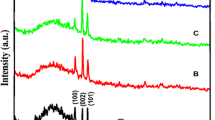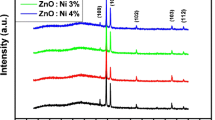Abstract
Ti-doped ZnO nanorods (NRs) have been deposited onto Si substrates at 93 °C by using chemical bath deposition method. FESEM observations show high-quality NRs. FTIR spectra display main peak around 560 cm−1 associated with Zn–O bond in addition to minor peak detected around 500 cm−1 referred to Ti–O bond. XRD patterns reveal the presence of the main (002) peak of the hexagonal wurtzite structure for all prepared films, where its intensity increases with increasing Ti doping, thereby indicating a very strong preferred orientation and batter crystallinity. Photoluminescence spectra exhibit a strong enhancement in both UV and visible emissions after Ti doping. Similarly, Raman spectroscopy shows sharp increment in E2(H) mode in doped films. The enhancement mechanism in both structural and optical properties of Ti-doped ZnO films have been investigated.






Similar content being viewed by others
References
Bidier, S.A., et al., Effect of growth time on Ti-doped ZnO nanorods prepared by low-temperature chemical bath deposition. Phys. E 88, 169–173 (2017)
F. Jiménez-García et al., Influence of substrate on structural, morphological and optical properties of ZnO films grown by SILAR method. Bull. Mater. Sci. 37(6), 1283–1291 (2014)
S. Xu, Z.L. Wang, One-dimensional ZnO nanostructures: solution growth and functional properties. Nano Res. 4(11), 1013–1098 (2011)
J. Hassan, Z. Hassan, H. Abu-Hassan, High-quality vertically aligned ZnO nanorods synthesized by microwave-assisted CBD with ZnO–PVA complex seed layer on Si substrates. J. Alloys Compd. 509(23), 6711–6719 (2011)
L. Vayssieres, Growth of arrayed nanorods and nanowires of ZnO from aqueous solutions. Adv. Mater. 15(5), 464–466 (2003)
Niu, X., W. Du, W. Du, Preparation and gas sensing properties of ZnM2O4 (M = Fe, Co, Cr). Sens. Actuators B 99(2), 405–409 (2004)
R.K. Chava, M. Kang, Improving the photovoltaic conversion efficiency of ZnO based dye sensitized solar cells by indium doping. J. Alloys Compd. 692, 67–76 (2017)
C.-L. Hsu et al., Vertical Ti doped ZnO nanorods based on ethanol gas sensor prepared on glass by furnace system with hotwire assistance. Sens. Actuators, B 192, 550–557 (2014)
R. Sridhar et al., Spectroscopic study and optical and electrical properties of Ti-doped ZnO thin films by spray pyrolysis. Spectrochim. Acta Part A 120, 297–303 (2014)
Z. Yong et al., Ti-doped ZnO thin films prepared at different ambient conditions: electronic structures and magnetic properties. Materials 3(6), 3642–3653 (2010)
L.-W. Ji et al., Effect of seed layer on the growth of well-aligned ZnO nanowires. J. Phys. Chem. Solids 70(10), 1359–1362 (2009)
Q. Shao et al., Ferromagnetism in Ti-doped ZnO thin films. J. Appl. Phys. 117(17), 17B908 (2015)
K. Zheng et al., The properties of ethanol gas sensor based on Ti doped ZnO nanotetrapods. Mater. Sci. Eng. B 166(1), 104–107 (2010)
Z.-Y. Ye et al., Structural, electrical, and optical properties of Ti-doped ZnO films fabricated by atomic layer deposition. Nanoscale Res. Lett. 8(1), 1–6 (2013)
Y. Kumar et al., Controlling of ZnO nanostructures by solute concentration and its effect on growth, structural and optical properties. Mater. Res. Express 2(10), 105017 (2015)
S. Kanmani, N. Rajamanickam, K. Ramachandran, Influence of Ti dopant on the properties and dye sensitized solar cell performance of ZnO chunk-shaped nanostructures. Org. Electron. 15(10), 2302–2310 (2014)
C.H. Hsu, W.S. Chen, C.H. Lai, F.S. Yan, Fabrication of Ti-doped ZnO thin films by chemical bath deposition. Adv. Mater. Res. 194–196, 2254–2258 (2011)
L. Lv et al., A template-free alcoholthermal route to Ti (Sn)-doped ZnO nanorods. Mater. Res. Bull. 45(4), 403–408 (2010)
A. Muaz et al., Effect of annealing temperatures on the morphology, optical and electrical properties of TiO2 thin films synthesized by the sol–gel method and deposited on Al/TiO2/SiO2/p-Si. Microsyst. Technol. 22, 871–881 (2015)
R.L. Hoye, K.P. Musselman, J.L. MacManus-Driscoll, Research update: doping ZnO and TiO2 for solar cells. APL Mater. 1(6), 060701 (2013)
National Institutes of Health. Titanium Dioxide. (2017), http://pubchem.ncbi.nlm.nih.gov/compound/26042#section=Chemical-and-Physical-Properties. Accessed 2017 Feb 16
J. Luque-Garcıa, M.L. De Castro, Ultrasound: a powerful tool for leaching. TrAC Trends Anal. Chem. 22(1), 41–47 (2003)
G. Jiaa, et al., Solution growth of well-aligned zno nanorods on sapphire substrate. Detail 4, 6 (2013)
J. Yang et al., Low-temperature growth and optical properties of ZnO nanorods. J. Alloys Compd. 450(1), 521–524 (2008)
O.F. Farhat et al., Morphological and structural characterization of single-crystal ZnO nanorod arrays on flexible and non-flexible substrates. Beilstein J. Nanotechnol. 6(1), 720–725 (2015)
S.M. Mohammad et al., Fabrication of low cost UV photo detector using ZnO nanorods grown onto nylon substrate. J. Mater. Sci. 26(3), 1322–1331 (2015)
G.N. Narayanan, R.S. Ganesh, A. Karthigeyan, Effect of annealing temperature on structural, optical and electrical properties of hydrothermal assisted zinc oxide nanorods. Thin Solid Films 598, 39–45 (2016)
Djaja, N.F., D.A. Montja, R. Saleh, The effect of Co incorporation into ZnO nanoparticles. Adv. Mater. Phys. Chem. 3, 33–34 (2013)
Shah, H., B.A.M. Manikandan, V. Ganesan, Enhanced bioactivity of Ag/ZnO nanorods-a comparative antibacterial study (Sbds). J. Nanomed. Nanotechnol. (2013). doi:10.4172/2157-7439.1000168
K.H. Kim et al., Morphological properties of Al-doped ZnO nano/microstructures. Superlattices Microstruct. (2016). doi:10.1016/j.spmi.2016.01.019
D. Tsiourvas et al., Covalent attachment of a bioactive hyperbranched polymeric layer to titanium surface for the biomimetic growth of calcium phosphates. J. Mater. Sci. 22(1), 85–96 (2011)
E.R. Waclawik et al., Functionalised zinc oxide nanowire gas sensors: enhanced NO2 gas sensor response by chemical modification of nanowire surfaces. Beilstein J. Nanotechnol. 3(1), 368–377 (2012)
Parvin, T., et al., Photocatalytic degradation of municipal wastewater and brilliant blue dye using hydrothermally synthesized surface-modified silver-doped ZnO designer particles. Int. J. Photoenergy (2012). doi:10.1155/2012/670610
N. Xu et al., Photoluminescence and low-threshold lasing of ZnO nanorod arrays. Opt. Express 20(14), 14857–14863 (2012)
S. Benramache et al., Correlation between crystallite size-optical gap energy and precursor molarities of ZnO thin films. J. Semicond. 35(4), 042001 (2014)
T. Akilan, N. Srinivasan, R. Saravanan, Magnetic and optical properties of Ti doped ZnO prepared by solid state reaction method. Mater. Sci. Semicond. Process. 30, 381–387 (2015)
S. Deshpande et al., Size dependency variation in lattice parameter and valency states in nanocrystalline cerium oxide. Appl. Phys. Lett. 87(13), 133113 (2005)
D.P. Rueda, J. Vadillo, J. Laserna, Effects of Post-growth Thermal Annealing on Room Temperature Pulsed Laser Deposited ZnO Thin Films. Journal of Physics: Conference Series (IOP Publishing, Bristol, 2016)
X. Li et al., Study of oxygen vacancies′ influence on the lattice parameter in ZnO thin film. Mater. Lett. 85, 25–28 (2012)
M. Babikier et al., Cu-doped ZnO nanorod arrays: the effects of copper precursor and concentration. Nanoscale Res. Lett. 9(1), 199 (2014)
A. Umar et al., Structural and optical properties of single-crystalline ZnO nanorods grown on silicon by thermal evaporation. Nanotechnology 17(16), 4072 (2006)
E.S. Shim et al., Annealing effect on the structural and optical properties of ZnO thin film on InP. Mater. Sci. Eng. B 102(1), 366–369 (2003)
B. Panigrahy et al., Defect-related emissions and magnetization properties of ZnO nanorods. Adv. Funct. Mater. 20(7), 1161–1165 (2010)
M. Gomi et al., Photoluminescent and structural properties of precipitated ZnO fine particles. Jpn. J. Appl. Phys. 42(2R), 481 (2003)
Hassan, N., M. Hashim, Y. Al-Douri, Morphology and optical investigations of ZnO pyramids and nanoflakes for optoelectronic applications. Optik-Int. J. Light Electron Optics, 125(11), 2560–2564 (2014)
B.E. Sernelius et al., Band-gap tailoring of ZnO by means of heavy Al doping. Phys. Rev. B 37(17), 10244 (1988)
X. Liu et al., Synthesis and field emission properties of highly ordered Ti-doped ZnO nanoarray structure. J. Mater. Sci. 24(8), 2839–2845 (2013)
A.M. Selman, Z. Hassan, M. Husham, Structural and photoluminescence studies of rutile TiO 2 nanorods prepared by chemical bath deposition method on Si substrates at different pH values. Measurement 56, 155–162 (2014)
W.J. Salcedo, F.J. Ramirez Fernandez, J.C. Rubimc, Influence of laser excitation on raman and photoluminescence spectra and FTIR study of porous silicon layers. Braz. J. Phys. 29(4), 751–755 (1999)
Q. Yang et al., Extended photoresponse and multi-band luminescence of ZnO/ZnSe core/shell nanorods. Nanoscale Res. Lett. 9(1), 31 (2014)
Acknowledgements
The authors gratefully acknowledge the financial support provided by the Institute of Postgraduate Studies (IPS) Universiti Sains Malaysia (USM) Fellowship and Institute of Nano-optoelectronics Research & Technology Laboratory (INOR), sains@usm, under grant No. 1001/CINOR/811239.
Author information
Authors and Affiliations
Corresponding author
Rights and permissions
About this article
Cite this article
Bidier, S.A., Hashim, M.R. & Bououdina, M. Structural and optical characteristics of Ti-doped ZnO nanorods deposited by simple chemical bath deposition. J Mater Sci: Mater Electron 28, 11178–11185 (2017). https://doi.org/10.1007/s10854-017-6905-7
Received:
Accepted:
Published:
Issue Date:
DOI: https://doi.org/10.1007/s10854-017-6905-7




